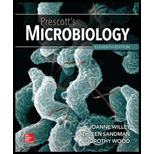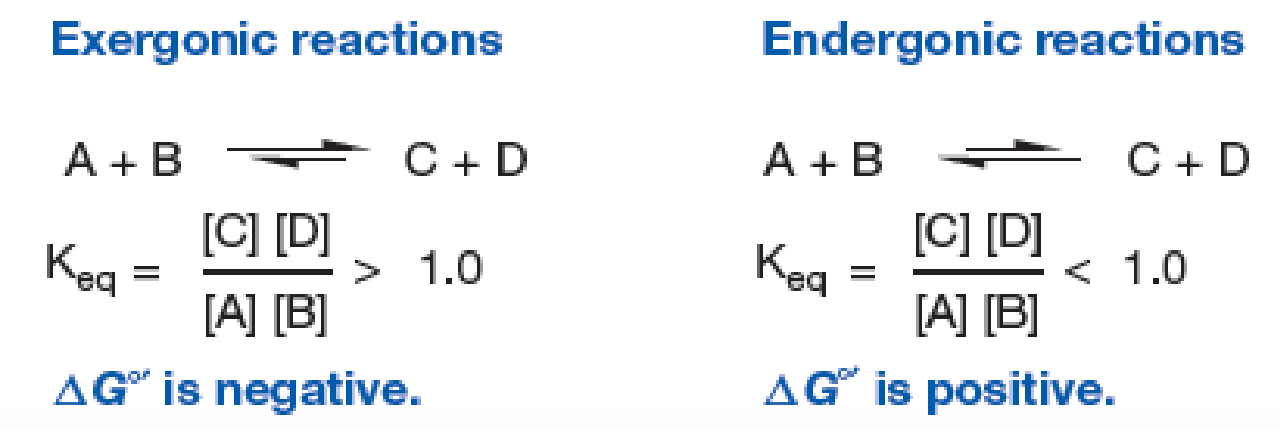
Prescott's Microbiology
11th Edition
ISBN: 9781260409062
Author: WILLEY, Joanne
Publisher: MCGRAW-HILL HIGHER EDUCATION
expand_more
expand_more
format_list_bulleted
Concept explainers
Textbook Question
Chapter 10.1, Problem 1MI

Figure 10.2 The Relationship of ΔG°′ to the Equilibrium of Reactions. Note the differences between exergonic and endergonic reactions.
Which reaction would release heat? Explain your answer.
Expert Solution & Answer
Want to see the full answer?
Check out a sample textbook solution
Students have asked these similar questions
inf
A particular reaction has a ΔG‡ of 37.0 kJ mol-1. In the presence of an enzyme, the same reaction has a ΔG‡ of 5.70 kJ mol-1. Calculate the value of ΔΔG‡ in kJ mol-1.
Figure 1
Figure 2
Reaction
Reaction
Abe notices that the temperature of the mixture in figure 1 gets
colder.
Abe nota que la temperatura de la mezcla en la figura 1 se vuelve más
fría.
A) Describe the systems (i.e. in the reaction and its surroundings), in
which the energy is conserved, represented by the two figures.
B) Explain why energy is neither created nor destroyed in these
systems.
Energy-
Energy
Chapter 10 Solutions
Prescott's Microbiology
Ch. 10.1 - Figure 10.2 The Relationship of G to the...Ch. 10.1 - Prob. 1CCCh. 10.1 - Prob. 2CCCh. 10.1 - Prob. 3CCCh. 10.1 - Prob. 4CCCh. 10.2 - Why is ATP called a high-energy molecule? How is...Ch. 10.2 - Describe the energy cycle and ATPs role in it....Ch. 10.3 - Prob. 1MICh. 10.3 - Prob. 2MICh. 10.4 - Figure 10.6 Electron Movement and Reduction...
Ch. 10.4 - How is the direction of electron flow between...Ch. 10.4 - When electrons flow from the NAD+/NADH conjugate...Ch. 10.4 - Which among the following would be the best...Ch. 10.4 - In general terms, how is G related to E0? What is...Ch. 10.4 - Name and briefly describe the major electron...Ch. 10.6 - Will an enzyme with a relatively high Km have a...Ch. 10.6 - Prob. 2MICh. 10.6 - Prob. 1CCCh. 10.6 - Prob. 2CCCh. 10.6 - How does enzyme activity change with substrate...Ch. 10.6 - What special properties might an enzyme isolated...Ch. 10.6 - What are competitive and noncompetitive...Ch. 10.6 - How are enzymes and ribozymes similar? How do they...Ch. 10.7 - Figure 10.19 Allosteric Regulation. The structure...Ch. 10.7 - Prob. 2MICh. 10.7 - Define the terms metabolic channeling and...Ch. 10.7 - Define allosteric enzyme and allosteric effector.Ch. 10.7 - Prob. 3CCCh. 10.7 - Prob. 4CCCh. 10.7 - Prob. 5CCCh. 10 - Prob. 1RCCh. 10 - Prob. 2RCCh. 10 - Prob. 3RCCh. 10 - Examine the structures of macromolecules in...Ch. 10 - Examine the branched pathway shown here for the...Ch. 10 - Prob. 3AL
Additional Science Textbook Solutions
Find more solutions based on key concepts
Why is it unlikely that two neighboring water molecules would be arranged like this?
Campbell Biology (10th Edition)
Why are mutants used as test organisms in the Ames test?
Laboratory Experiments in Microbiology (12th Edition) (What's New in Microbiology)
Some people consider Pasteur or Koch to be the Father of Microbiology, rather than Leeuwenhoek. Why might they ...
Microbiology with Diseases by Body System (5th Edition)
Knowledge Booster
Learn more about
Need a deep-dive on the concept behind this application? Look no further. Learn more about this topic, biology and related others by exploring similar questions and additional content below.Similar questions
- Which one of the following statements is completely TRUE? O When AG > 0, the reaction is BOTH product-favored (spontaneous) AND endergonic. When AG 0, the reaction is BOTH reactant-favored (nonspontaneous) AND endergonic. When AG > 0, the reaction is BOTH product-favored (spontaneous) AND exergonic. When AG > 0, the reaction is BOTH reactant-favored (nonspontaneous) AND exergonic. When AG < 0, the reaction is BOTH reactant-favored (nonspontaneous) AND exergonic.arrow_forwardOn the free energy diagram shown, label the intermediate (s) and transition state(s). Is the reaction thermodynamically favorable? Reaction.arrow_forwardT/F A catalyst changes only the rate at which equilibrium is achieved; it has no effect on the position of the equilibrium. This means that a catalyst can enhance the rate of exergonic reactions but cannot somehow change the ΔG′ to allow an endergonic reaction to become spontaneousarrow_forward
- this one represents an endothermic reaction. Things are similar: the flat line on the left (beginning of the reaction) is the total energy possessed by the reactant molecules; once again, kJ stands for energy in kiloJoules, thousands of Joules. The flat line on the right (reaction complete) is the total energy of the products. Since an endothermic reaction has a net absorption of energy (taking this extra energy from the surroundings), the products have higher energy than the reactants. Question: the energy of the reactant molecules is kJ. [to answer, simply identify the correct y-axis coordinate.] 250 200 PE (kJ) 150 100 50 Reaction pathwayarrow_forwardDetermine the direction that each of the reactions will progress. Assume that the reactants and products are present in equimolar amounts. The standard free energy of hydrolysis of ATP is - 30.5 kJ/mol. fructose + ATP fructose 6-phosphate + ADP The standard free energy of hydrolysis for fructose 6-phosphate is -15.9 kJ/mol. 3-phosphoglycerate + ATP 1,3-bisphosphoglycerate + ADP The standard free energy of hydrolysis for 1,3-bisphosphoglycerate is -49.3 kJ/mol. creatine + ATP creatine phosphate + ADP The standard free energy of hydrolysis for creatine phosphate is -43.0 kJ/mol.arrow_forwardThe following questions are based on the reaction A+ B ↔ C+D shown in Figure 8.1. 1. Which of the following terms best describes the progress of the reaction with respect to free energy change? a) endergonic, ∆G> 0 b) exergonic, ∆G> 0 c) exergonic, ∆G< 0 d) endergonic, ∆G< 0 2. Which of the following in Figure 8.1 remains unchanged by having an enzyme included? a) b b) d c) a d) c 3. The part labeled “C” on the above graph represents a) Energy of activation without enzyme b) Energy of activation with enzyme c) Amount of free energy released d) amount of energy required for the reaction progressarrow_forward
- if the reaction given below occurs and pure A and B were mixed, which of the following would take place as equilibrium was established A + B ⇌ C a. the concentration of C would increase for a time, then remain constant b. the concentration of A would increase for a time, then decrease c. the concentration of B would increase for a time, then remain constantarrow_forwarduce the observations about each chemical reaction in the table below to decide the sign (positive or negative) of the reaction enthalpy AH and reaction entropy Note: if you have not been given enough information to decide a sign, select the "unknown" option. reaction observations conclusions The reverse of this reaction is always spontaneous but proceeds slower at temperatures below 132. °C. AH is (pick one) AS is (pick one) His (pick one) B This reaction is endothermic. AS is (pick one) This reaction is spontaneous except below 110. °C but proceeds at a slower rate below 135. °C. AH IS (pick one) AS is (pick one)varrow_forwardWhich of the following statements are true for BOTH the "transition state" and an "intermediate" of reaction? (This is a multi-select question, select all that apply.). Both are only observed in enzyme-catalyzed reactions. Both can be converted to product(s) or might decompose back to the reactant(s). Neither are part of the "net equation" for the reaction. Both contain covalent bonds are in the process of breaking and/or forming. Both are part of every chemical reaction. (i.e. the mechanisms of all chemical reactions, whether enzyme catalyzed or not, will have involve both a transition state and an intermediate).arrow_forward
- Consider the analogy of the jiggling box containing coins that was described on page 85. The reaction, the flipping of coins that either face heads up (h) or tails up (T), is described by the equation h ↔ T, where the rate of the forward reaction equals the rate of the reverse reaction.a. What are ΔG and ΔG° in this analogy? b. What corresponds to the temperature at which the reaction proceeds? What corresponds to the activation energy of the reaction? assume you have an “enzyme,” called jigglase, which catalyzes this reaction. What would the effect of jigglase be and what, mechanically, might jigglase do in this analogy?arrow_forward(please type answer no write by hend)arrow_forwardWhich of the following aspects of catalysis by enzymes can NOT be explained by the Fischer Lock and Key Hypothesis? Enzymes will lower the activation energy barrier for reaction. Enzymes will specifically recognize their substrates. Appropriate substrates will bind to the enzyme to form a Michaelis complex. Enzymes have an "active site" where appropriate substrates will be bound. Two of the above cannot be explained by the Fischer "Lock and Key" Hypothesis.arrow_forward
arrow_back_ios
SEE MORE QUESTIONS
arrow_forward_ios
Recommended textbooks for you
 Biology 2eBiologyISBN:9781947172517Author:Matthew Douglas, Jung Choi, Mary Ann ClarkPublisher:OpenStax
Biology 2eBiologyISBN:9781947172517Author:Matthew Douglas, Jung Choi, Mary Ann ClarkPublisher:OpenStax Biology (MindTap Course List)BiologyISBN:9781337392938Author:Eldra Solomon, Charles Martin, Diana W. Martin, Linda R. BergPublisher:Cengage Learning
Biology (MindTap Course List)BiologyISBN:9781337392938Author:Eldra Solomon, Charles Martin, Diana W. Martin, Linda R. BergPublisher:Cengage Learning

Biology 2e
Biology
ISBN:9781947172517
Author:Matthew Douglas, Jung Choi, Mary Ann Clark
Publisher:OpenStax

Biology (MindTap Course List)
Biology
ISBN:9781337392938
Author:Eldra Solomon, Charles Martin, Diana W. Martin, Linda R. Berg
Publisher:Cengage Learning
The Cell Membrane; Author: The Organic Chemistry Tutor;https://www.youtube.com/watch?v=AsffT7XIXbA;License: Standard youtube license